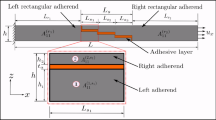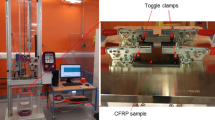Abstract
This paper analyzes the propagation of a cohesive crack through a reinforcement layer and gives a solution that can be used for any specimen and loading condition. Here it faces the case of a reinforced prismatic beam loaded at three points. Reinforcement is represented by means of a free-slip bar bridging the cracked section, anchored at both sides of the crack at a certain distance that is called the effective slip length. This length is obtained by making the free-slip bar mechanically equivalent to the actual adherent reinforcement. With this model, the crack development depends on three parameters (apart from those that represent the specimen geometry): the size of the specimen, the cover thickness of the layer and the reinforcement strength. The latter depends on the reinforcement ratio and its adherence to the matrix while the reinforcement is in the elastic regime; otherwise, on the reinforcement ratio and its yielding strength. The thickness of the reinforcement cover influences the first stages of the development of the cohesive crack, and thus it also affects the value of the load peak. The computed load-displacement curves display a noticeable size effect, as real cohesive materials do. Finally, the model is able to fit the available experimental results, and accurately reproduces the influence of size, amount of reinforcement and adherence variations in the tests.
Similar content being viewed by others
References
Bache, H.H. (1994). Design for ductility. In: Concrete Technology: New Trends, Industrial Applications, E & FN Spon, London, 113–125.
Baluch, M.H., Azad, A.K. and Ashmawi, W. (1992). Fracture mechanics application to reinforced concrete members in flexure. In: Applications of Fracture Mechanics to Reinforced Concrete, Elsevier, London, 413–436.
Bažant, Z.P. and Cedolin, L. (1980). Fracture mechanics of reinforced concrete. Journal of the Engineering Mechanics Division 106, 1257–1306.
Bažant, Z.P. and Planas, J. (1998). Fracture and Size Effect in Concrete and Other Quasibrittle Materials, CRC Press, Boca Raton, Florida.
Bažant, Z.P. and Sener, S. (1988). Size effects in pull-out tests. ACI Materials Journal 85, 347–351.
Bosco, C. and Carpinteri, A. (1990). Fracture mechanics evaluation of minimum reinforcement in concrete structures. In: Applications of Fracture Mechanics to Reinforced Concrete, Elsevier, London, 347–377.
Bosco, C. and Carpinteri, A. (1992). Fracture behaviour of beam cracked across reinforcement. Theoretical and Applied Fracture Mechanics 17, 61–68.
Brincker, R., Henriksen, M.S., Christensen, F.A. and Heshe, G. (1999). Size effects on the bending behaviour of reinforced concrete beams. In: Minimum Reinforcement in Concrete Members, Elsevier, London, 127–180.
Fantilli, A.P., Ferretti, D., Iori, I. and Vallini, P. (1999). Behaviour of R/C elements in bending and tension: the problem of minimum reinforcement ratio. In: Minimum Reinforcement in Concrete Members, Elsevier, London, 99–125.
Gerstle, W.H., Partha, P.D., Prasad, N.N.V., Rahulkumar, P. and Ming, X. (1992). Crack growth in flexural members. – A fracture mechanics approach. ACI Structural Journal 89, 617–625.
Hawkins, N. and Hjorsetet, K. (1992). Minimum reinforcement requirement for concrete flexural members. In: Applications of Fracture Mechanics to Reinforced Concrete, Elsevier, London, 37–412.
Hededal, O. and Kroon, I.B. (1991). Lightly Reinforced High-Strength Concrete. M.Sc. Thesis, University of Åalborg, Denmark.
Hillerborg, A., Modéer, M. and Petersson, P. (1976). Analysis of crack formation and crack growth in concrete by means of fracture mechanics and finite elements. Cement and Concrete Research 6, 773–782.
Malvar, L.J. (1992). Confinement stress dependent bond behaviour. Part I: experimental investigation. In: Bond in Concrete. From Research to Practice, Vol. 1, 79–88.
Massabò, R. (1994). Meccanismi di Rottura nei Materiali Fibrorinforzati. Dottorato di Ricerca in Ingegeneria Strutturale, Politecnico di Torino, Italy.
Mazars, J., Pijaudier-Cabot, G. and Clement, J.L. (1992). Analysis of steel-concrete bond with damage mechanics: non linear behaviour and size effect. In: Applications of Fracture Mechanics to Reinforced Concrete, Elsevier, London, 307–331.
McDowell, D.L. ed. (1997). Applications of Continuum Damage Mechanics to Fatigue and Fracture. ASTM Special Technical Publication 1315, Ann Arbor, MI.
Melan, E. (1932). Der spannungzustand der durch eine einzelkraft im innern beanspruchten halbschiebe. 2 Angew. Math. Mech. 12, Heft 6.
Morita, S., Fuji, S. and Kondo, G. (1994). Experimental study on size effect in concrete structures. In: Size Effect in Concrete Structures, E & FN Spon, London, 21–40.
Ozbolt, J. and Bruckner, M. (1999). Minimum reinforcement requirement for RC beams. In: Minimum Reinforcement in Concrete Members, Elsevier, London, 181–201.
Planas, J. and Elices, M. (1991). Nonlinear fracture of cohesive materials. International Journal of Fracture 51, 139–157.
Planas, J. and Elices, M. (1992). Shrinkage eigenstresses and structural size effect. In: Fracture Mechanics of Concrete Structures, Elsevier, London, 939–950.
Planas, J. and Elices, M. (1993). Drying shrinkage effect on the modulus of rupture. In: Creep and Shrinkage of Concrete, E & FN Spon, London, 357–368.
Petersson, P.E. (1981). Crack Growth and Development of Fracture Zones in Plain Concrete and Similar Materials. Report TVBM-1006, Division of Building Materials, Lund Institute of Technology, University of Lund, Sweden.
Ruiz, G. (1998). Influencia del tamaño y de la adherencia en la armadura mínima de vigas en flexión. Grupo Español del Hormigón (GEHO) – Instituto Español del Cemento y sus Aplicaciones (IECA), Madrid.
Ruiz, G. and Planas, J. (1994). Propagación de una fisura cohesiva en vigas de hormigón débilmente armadas: modelo de la longitud efectiva de anclaje. Anales de Mecánica de la Fractura 11, 506–513.
Ruiz, G., Elices, M. and Planas, J. (1998). Experimental study on fracture of reinforced concrete beams. Materials and Structures 31, 683–691.
Ruiz, G., Elices, M. and Planas, J. (1999). Size effect and bond-slip dependence of lightly reinforced concrete beams. In: Minimum Reinforcement in Concrete Members, Elsevier, London, 67–97.
Ruiz, G., Planas, J. and Elices, M. (1993). Propagación de una fisura cohesiva en vigas de hormigón débilmente armadas, Anales de Mecánica de la Fractura 10, 141–146.
Ulfkjær, J.P., Hededal, O., Kroon, I.B. and Brincker, R. (1994). Simple application of fictitious crack model in reinforced concrete beams – Analysis and experiments. In: Size Effect in Concrete Structures, E & FN Spon, London, 281–292.
Author information
Authors and Affiliations
Rights and permissions
About this article
Cite this article
Ruiz, G. Propagation of a cohesive crack crossing a reinforcement layer. International Journal of Fracture 111, 265–282 (2001). https://doi.org/10.1023/A:1012260410704
Issue Date:
DOI: https://doi.org/10.1023/A:1012260410704




